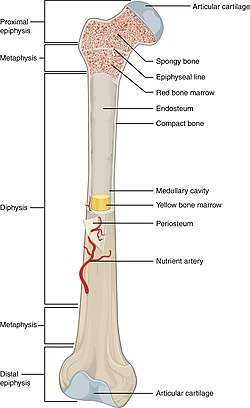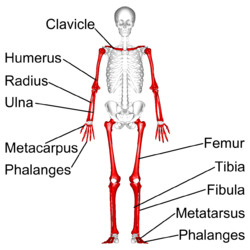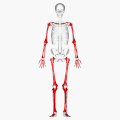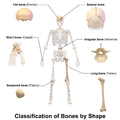Long bone
| Long bone | |
|---|---|
 Structure of a long bone (femur) | |
 Long bones in human skeleton (shown in red) | |
| Details | |
| Identifiers | |
| Latin | os longum |
| TA98 | A02.0.00.011 |
| TA2 | 369 |
| FMA | 7474 |
| Anatomical terms of bone | |
The long bones are those that are longer than they are wide. They are one of five types of bones: long, short, flat, irregular and sesamoid. Long bones, especially the femur and tibia, are subjected to most of the load during daily activities and they are crucial for skeletal mobility. They grow primarily by elongation of the diaphysis, with an epiphysis at each end of the growing bone. The ends of epiphyses are covered with hyaline cartilage ("articular cartilage"). The longitudinal growth of long bones is a result of endochondral ossification at the epiphyseal plate. Bone growth in length is stimulated by the production of growth hormone (GH), a secretion of the anterior lobe of the pituitary gland.
The long bone category includes the femora, tibiae, and
The outside of the bone consists of a layer of connective tissue called the
Structure
The outer shell of the long bone is made of
-
Long bones in human skeleton (shown in red)
-
Parts of a long bone (Femur)
-
Classification of bones by shape
-
Distribution of forces on a long bone (Femur)
-
Part of a long bone of a large ungulate
Clinical significance
There are two
There is a surgical procedure called distraction osteogenesis which is used to lengthen long bones.[3]
References
- ISBN 9780357390597.
- ^ ISBN 978-1-4160-6257-8.
- ISBN 9781489975843.





